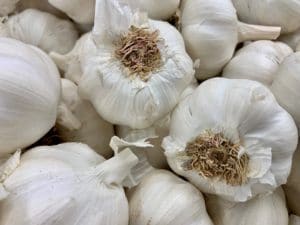Hello Fellow Readers,
Karen of Washington, NJ, emailed, “When should I plant garlic? I’m going to put leaves in my raised beds. Should I mix them in with dirt or just lay leaves on top?” Two great questions!
Garlic, Allium sativum, can be planted in the fall or early spring as soon as the ground is workable. But by planting mid-fall, you’ll be graced with fuller cloves, and healthier plants as the roots will be busy all winter becoming established.
Raised beds supplemented with composted soil, including leaf mold we spoke about a few weeks back (link to Leaf Manners), are excellent for growing vegetables. Or find a sunny spot with well-drained soil. Don’t plant new garlic where garlic or onions have grown recently. Like all vegetables, rotating crops from year to year helps maintain and enhance soil fertility as well as deter pests. Loosen the soil by digging up the top six inches.
How to Plant Garlic
 Peel off the outside papery enclosure called the tunic and separate the cloves – each will grow into a garlic bulb. Dig holes six inches apart and three to four inches deep with each row a foot apart. Or use a bulb probe called a dibbler that dates to Roman times when pointed wooden sticks were used to make holes for seeds and small bulbs. Now there are nifty metal and plastic dibblers.
Peel off the outside papery enclosure called the tunic and separate the cloves – each will grow into a garlic bulb. Dig holes six inches apart and three to four inches deep with each row a foot apart. Or use a bulb probe called a dibbler that dates to Roman times when pointed wooden sticks were used to make holes for seeds and small bulbs. Now there are nifty metal and plastic dibblers.
Plant each clove pointy end up and cover with soil. Place three inches of mulch or chopped leaves (my preference) on top to protect from heaving during freeze and thaw cycles. Cutting up the leaves by running them over with the lawnmower or using a leaf shredder is critical, so they don’t mat down and inhibit water flow.
Caring for Garlic Bulbs
Come spring when the garlic starts to grow, add bone meal or fertilizer around each plant. If your variety produces flowers, cut them off, so all the energy goes into bulb production.
About June, garlic will stop making new leaves and begin to form bulbs. At that time, it’s best to move the mulch aside as bulbs prefer to be on the dry side.
Harvesting & Storing Garlic
Once the leaves have turned brown, it’s time to harvest – typically in mid-July to early August here in New Jersey. Bulbs will separate if left too long. After harvesting, lay bulbs in the sun for a few hours then move them to a dry shady area with good circulation for about two or three weeks. Once the roots dry out, you can rub them off.
I adore garlic leaves braided together, turning bulbs into a decoration as they hang inside is a cool storage spot. Or cut the leaves a few inches above the bulb and lay them on shelves with slats or on screens.
Types of Garlic Bulbs
While you can grow garlic from bulbs bought at the grocer, it’s better not to. They may carry diseases such as garlic bloat nematode that can devastate other crops and hydrangea and iris. Plus, store-bought varieties may not grow in your zone. Instead, buy bulbs meant for planting.
There are many to choose from, but two main types – Soft-neck (var. sativum) and hard-neck or stiff-neck garlic (var. ophioscorodon). Hard necks are more winter hardy; their cloves are heftier and easier to peel, but they only last four to six months in storage. It’s the soft necks foliage that is braid-able, and their cloves can last up to a year. Long-lasting versus hardier to cold? Why not plant both.
Garden Dilemmas? AskMaryStone@gmail.com.
You may recall Karen and Jim inspired the column about the Birds and Bees of Zucchini, also featured in Episode 2 of my new Podcast.


